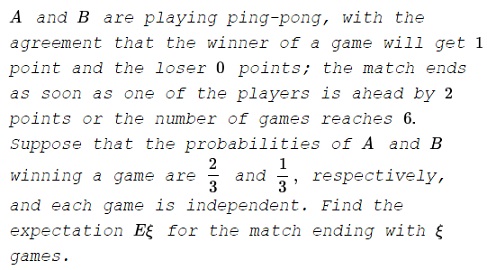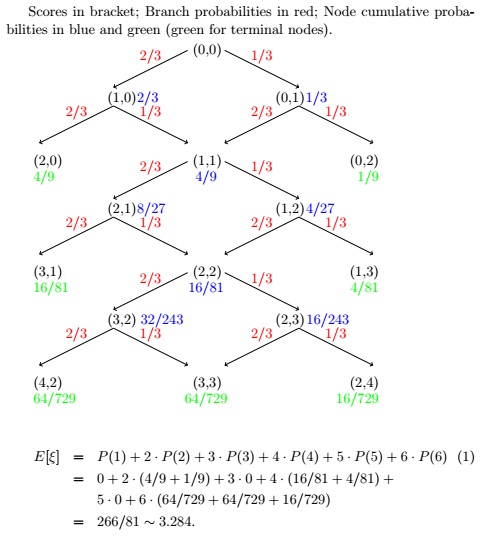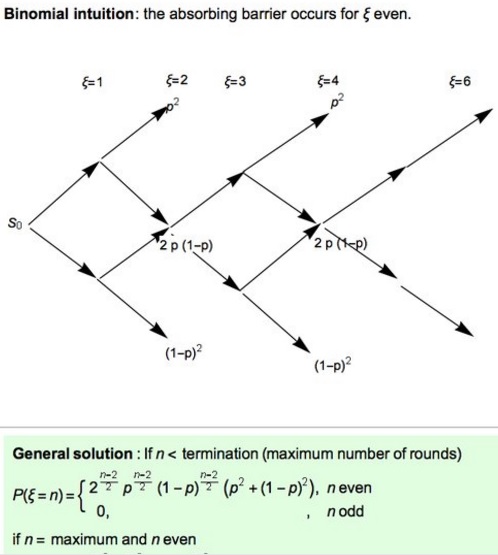Getting Ahead by Two Points

Solution 1
It is easy to see that $\xi\,$ can only be 2,4,6;1,3,5;1,3,6;2,3,5;2,4,6. So, we divide six games into three rounds of two consecutive games each. If one of the players wins two games in the first round, the match ends with the probability of
\displaystyle \left(\frac{2}{3}\right)^2+\left(\frac{1}{3}\right)^2=\frac{5}{9};$\displaystyle \left(\frac{2}{3}\right)^2+\left(\frac{1}{3}\right)^2=\frac{5}{9}$;$\displaystyle 1-\left[\left(\frac{2}{3}\right)^2+\left(\frac{1}{3}\right)^2\right]=\frac{4}{9}$;$\displaystyle \left(\frac{2}{3}\right)\left(\frac{1}{3}\right)=\frac{2}{9}$;$\displaystyle 1-\left(\frac{2}{3}\right)\left(\frac{1}{3}\right)=\frac{7}{9}$.
Otherwise, the players tie with each other, earning 1;$0$;$1$;$2$ point(s) each, and the match enters the second round, the probability of this happening is \displaystyle \frac{4}{9};$\displaystyle \frac{2}{9}$;$\displaystyle \frac{3}{9}$;$\displaystyle \frac{4}{9}$;$\displaystyle \frac{5}{9}$
We have similar discussions for the second and the third rounds. Thus, $\displaystyle P(\xi =2)=\frac{5}{9},\,$ $\displaystyle P(\xi =4)=\frac{4}{9}\cdot\frac{5}{9}=\frac{20}{81},\,$ $P(\xi =6)=$\displaystyle \left(\frac{4}{9}\right)^2=\frac{16}{81};$\displaystyle \left(\frac{4}{9}\right)^2=\frac{16}{81}$;$\displaystyle \left(\frac{4}{9}\right)^3=\frac{64}{729}$;$\displaystyle \left(\frac{4}{9}\right)^2\cdot\frac{5}{9}=\frac{100}{729}$
Finally,
$E\xi=$2;2;4;6$\cdot\displaystyle\frac{5}{9}+$4;2;4;6$\cdot\displaystyle\frac{20}{81}+$6;2;4;6$\cdot\displaystyle\frac{16}{81}=\frac{266}{81}.$
Solution 2
Let $A_k\,$ denote the event that $A\,$ wins the $k\text{th}\,$ game, while $\overset{\_}{A_k}\,$ means that $B\,$ wins the game. Since $A_k\,$ and $\overset{\_}{A_k}\,$ are incompatible, and are independent of the other events, we have
$\displaystyle\begin{align}P(\xi=2)&=P(A_1A_2)+P(\overset{\_}{A_1}\overset{\_}{A_2})=\frac{5}{9},\\ P(\xi=4)&=P(A_1\overset{\_}{A_2}A_3A_4)+P(A_1\overset{\_}{A_2}\overset{\_}{A_3}\overset{\_}{A_4})+P(\overset{\_}{A_1}A_2A_3A_4)+P(\overset{\_}{A_1}A_2\overset{\_}{A_3}\overset{\_}{A_4})\\ &=2\left[\left(\frac{2}{3}\right)^2\left(\frac{1}{3}\right)+\left(\frac{1}{3}\right)^2\left(\frac{2}{3}\right)\right]\\ &=\frac{20}{81}\\ P(\xi=6)&=P(A_1\overset{\_}{A_2}A_3\overset{\_}{A_4})+P(A_1\overset{\_}{A_2}\overset{\_}{A_3}A_4)+P(\overset{\_}{A_1}A_2A_3\overset{\_}{A_4})+P(\overset{\_}{A_1}A_2\overset{\_}{A_3}A_4)\\ &=4\left(\frac{2}{3}\right)^2\left(\frac{1}{3}\right)^2\\ &=\frac{16}{81} \end{align}$
It follows that,
$E\xi=2\cdot$\displaystyle\frac{5}{9};$\displaystyle\frac{5}{9}$;$\displaystyle\frac{20}{81}$;$\displaystyle\frac{16}{81}$$+4\cdot$\displaystyle\frac{20}{81};$\displaystyle\frac{5}{9}$;$\displaystyle\frac{20}{81}$;$\displaystyle\frac{16}{81}$$+6\cdot$\displaystyle\frac{16}{81};$\displaystyle\frac{5}{9}$;$\displaystyle\frac{20}{81}$;$\displaystyle\frac{16}{81}$$\displaystyle =\frac{266}{81}.$
Solution 3
Amit Itagi came up with a graphical representation of the solution.

Solution 4
Nassim Nicholas Taleb has offered his interpretation:

Acknowledgment
- Xiong Bin, Lee Peng Yee, Mathematical Olympiads in China (2009-2010). Problems and Solutions, World Scientific, 2013, #3
- What Is Probability?
- Intuitive Probability
- Probability Problems
- Sample Spaces and Random Variables
- Probabilities
- Example: A Poker Hand
- Bernoulli Trials
- Binomial Distribution
- Getting Ahead by Two Points
- Proofreading Example
- Conditional Probability
- Dependent and Independent Events
- Algebra of Random Variables
- Expectation
- Probability Generating Functions
- Probability of Two Integers Being Coprime
- Random Walks
- Probabilistic Method
- Probability Paradoxes
- Symmetry Principle in Probability
- Non-transitive Dice
|Contact| |Front page| |Contents| |Algebra|
Copyright © 1996-2018 Alexander Bogomolny
73510190
